History
Marine Ground Control Intercept Squadron 21 (MGCIS-21) was commissioned on 15 May 1947 at Naval Air Station Squantum, Massachusetts. They provided early warning and ground control intercept as part of the Marine Air Reserve Training Command until they were decommissioned on 30 November 1950. The squadron was reactivated on 18 January 1952 and in December 1953 moved to Naval Air Station South Weymouth. On 1 March 1954 they were re-designated as Marine Air Control Squadron 21 (MACS-21) and operated as such until their deactivation on 31 July 1962.
The squadron was quickly repurposed and brought back on 1 August 1962 as Marine Air Traffic Control Unit 73 (MATCU-73). MATCU-73 was responsible for providing air traffic control and precision approach radar services at NAS South Weymouth. This new designation did not last long because on 1 January 1963 they reverted to MACS-21.
On 1 April 1967 the squadron would gain its current moniker when it was re-designated Marine Air Support Squadron 6 (MASS-6). \Elements of MASS-6 would help support Operation Desert Storm in 1990/1991. After the Gulf War and in light of the Base Realignment and Closure (BRA) military downturn, the unit was relocated to Westover Air Force Base and occupied duplexes for 9 years until a new Marine Reserve Center was built with the politic backing of both sides of the political aisle.
Operation Iraqi Freedom For the 2003 invasion of Iraq, the DASC for the I Marine Expeditionary Force was provided by MASS-3 with augmentation from MASS-1 and MASS-6. It was broken up into a main echelon (DASC Main) and a forward echelon (DASC Fwd). The main was attached to the Main Headquarters of the 1st Marine Division while the forward was attached to the Division "Jump Command Post (CP)." The DASC (Fwd) was also a part of Task Force Tripoli when they went into Tikrit at the end of the invasion. Air support Marines also provided a smaller DASC for Task Force Tarawa, the British Forces on the Al Faw Peninsula, staffed a DASC (A) detachment out of Ahmad al-Jaber Air Base in Kuwait and provided Air Support Liaison Teams (ASLTs) to all of the regiments within the 1st Marine Division.
MASS-3 returned to Iraq with the 1st Marine Division to provide air support in January 2004. They were based out of Camp Blue Diamond in Ramadi and were replaced in January 2005 by MASS-1. The DASC moved to Camp Fallujah near the city of Fallujah in January 2006 around the same time that MASS-3 returned to Iraq to retake the air support mission in Al Anbar Province. MASS-1 again switched out with MASS-3 in early 2007 and provided air support for the 2nd Marine Division.
Marine Air Support Squadron 6 Marines now wear the Naval Aviation Observer Wings they were awarded March 25, 2011. The wings were typically awarded to operators of the OV-10 Bronco surveillance aircraft only, which were phased out of service in 1995. According to Marine Administrative Message 091/11, released Feb. 11, Marines involved with air support control operations may now wear the wings as well.
In addition the Unit received numerous commendations for NATO exercises Battle Griffin in Norway as well as providing support to Combined Arms Exercises at 29 Palms, CA, Marine Combat Center. During these exercises in the 1980, the Reserve Unit created what is now a standard protocol for all Marine Air Support Units by creating the Air Support Liaison Party or ASLP. Originally designed to get the most up to the minute status on enemy air, troop movements close air support missions and medevacs inside the Battalion S-3 Operations, it quickly became a necessity for ground units to rely on for communications and close air support with forward air controllers. Today every battalion or regiment rates an ASLT when deploying either in a MEU (Marine Expeditionary Unit) or MEB (Marine Expeditionary Brigade) to all corners of the globe.
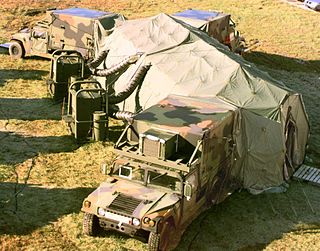
The Direct Air Support Center (DASC) is the principal United States Marine Corps aviation command and control system and the air control agency responsible for the direction of air operations directly supporting ground forces. It functions in a decentralized mode of operation, but is directly supervised by the Marine Tactical Air Command Center (TACC) or the Navy Tactical Air Control Center (NTACC). During amphibious or expeditionary operations, the DASC is normally the first Marine Air Command and Control System (MACCS) agency ashore and is usually categorized as the Ground Combat Element's (GCE's) senior Fire Support Coordination Center (FSCC). The DASC's parent unit is the Marine Air Support Squadron (MASS) of the Marine Air Control Group (MACG).

Marine Air Support Squadron 3 (MASS-3), is a United States Marine Corps aviation command and control unit that provides the Direct Air Support Center (DASC) for the 1st Marine Expeditionary Force. They are based out of the 32 Area on Marine Corps Base Camp Pendleton, California and fall under the command of Marine Air Control Group 38 and the 3rd Marine Aircraft Wing.
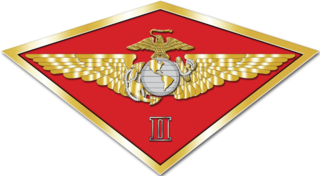
The 2nd Marine Aircraft Wing is the major east coast aviation unit of the United States Marine Corps and is headquartered in Marine Corps Air Station Cherry Point, North Carolina. The Wing provides the aviation combat element for the II Marine Expeditionary Force.

Marine Light Attack Helicopter Squadron 369 (HMLA-369) is a United States Marine Corps helicopter squadron consisting of AH-1Z Viper attack helicopters and UH-1Y Venom utility helicopters. The squadron, also known as the "Gunfighters", is based at Marine Corps Air Station Camp Pendleton, California and falls under the command of Marine Aircraft Group 39 (MAG-39) and the 3rd Marine Aircraft Wing.

Marine Light Attack Helicopter Squadron 169 (HMLA-169) is a United States Marine Corps helicopter squadron consisting of AH-1Z Viper attack helicopters and UH-1Y Huey utility helicopters. The squadron is based at Marine Corps Air Station Camp Pendleton, California and falls under the command of Marine Aircraft Group 39 (MAG-39) and the 3rd Marine Aircraft Wing.
Marine Air-Ground Task Force is a term used by the United States Marine Corps to describe the principal organization for all missions across the range of military operations. MAGTFs are a balanced air-ground, combined arms task organization of Marine Corps forces under a single commander that is structured to accomplish a specific mission. The MAGTF was formalized by the publishing of Marine Corps Order 3120.3 in December 1963 "The Marine Corps in the National Defense, MCDP 1-0". It stated:

Marine Air Support Squadron 2 (MASS-2), is a United States Marine Corps aviation command and control unit that provides the Direct Air Support Center (DASC) for the III Marine Expeditionary Force. It is the oldest and most decorated aviation command and control unit in the Marine Corps.
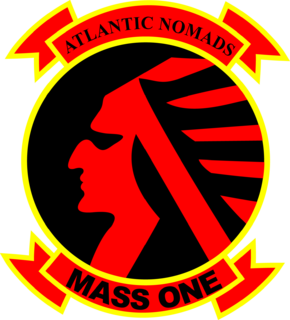
Marine Air Support Squadron 1 (MASS-1) is a United States Marine Corps aviation command and control unit that provides the Direct Air Support Center to coordinate close air support for the II Marine Expeditionary Force. Callsign "Cheiftain," the squadron is based out of Marine Corps Air Station Cherry Point, North Carolina, and falls under the command of Marine Air Control Group 28 and the 2nd Marine Aircraft Wing.

Marine Aircraft Group 26 (MAG-26) is a United States Marine Corps aviation unit based at Marine Corps Air Station New River composed of seven MV-22 Osprey squadrons, one of which is the Fleet Replacement Squadron, an aviation logistics squadron, and a wing support squadron. It falls under the command of the 2nd Marine Aircraft Wing and II Marine Expeditionary Force.

Marine Wing Support Squadron 271 is an aviation ground support unit of the United States Marine Corps. They are based at Marine Corps Air Station Cherry Point, North Carolina. The squadron falls under the command of Marine Aircraft Group 14 and the 2nd Marine Aircraft Wing.

The Marine Wing Support Squadron 373 is an aviation ground support unit of the United States Marine Corps. They are based out of Marine Corps Air Station Miramar, California. The squadron is part of Marine Aircraft Group 11 and the 3rd Marine Aircraft Wing.
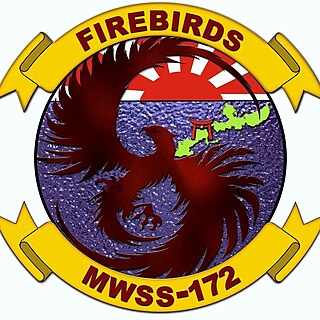
Marine Wing Support Squadron 172 is an aviation support unit of the United States Marine Corps's 1st Marine Aircraft Wing. Known as the "Firebirds", they are based out of Camp Foster, Okinawa, Japan. Previously part of Marine Wing Support Group 17 before they disbanded, MWSS-172 now falls under Marine Aircraft Group 36.

4th Light Armored Reconnaissance Battalion is a fast and mobilized armored terrestrial reconnaissance battalion of the United States Marine Corps reserve. Their primary weapon system is the LAV-25 and they are part of the 4th Marine Division and Marine Forces Reserve. The unit headquarters is at Camp Pendleton, California, but other units in the battalion are located throughout the United States. 4th LAR Bn is the largest combat battalion in the Marine Corps, with 7 companies.

The 11th Marine Expeditionary Unit is one of seven Marine Expeditionary Units currently in existence in the United States Marine Corps. The Marine Expeditionary Unit is a Marine Air Ground Task Force with a strength of about 2,200 personnel. The MEU consists of a command element, a reinforced infantry battalion, a composite helicopter squadron and a logistics combat element. The 11th MEU is currently based out of Marine Corps Base Camp Pendleton, California with headquarters in Camp Del Mar.

2d Low Altitude Air Defense Battalion is an air defense unit of the United States Marine Corps. They are part of Marine Air Control Group 28 (MACG-28) and the 2nd Marine Aircraft Wing and are currently based at Marine Corps Air Station Cherry Point. The Battalion is composed of one Headquarters and Support Battery and two Firing Batteries.

Marine Wing Communications Squadron 28 (MWCS-28) is a United States Marine Corps communications squadron. The squadron provides expeditionary communications for the aviation combat element of the II Marine Expeditionary Force. They are based at Marine Corps Air Station Cherry Point and fall under the command of Marine Air Control Group 28 and the 2nd Marine Aircraft Wing.

Marine Wing Communications Squadron 38 (MWCS-38) is a United States Marine Corps communications squadron. The squadron provides expeditionary communications for the aviation combat element of the I Marine Expeditionary Force. They are based at Marine Corps Air Station Miramar, California, and fall under the command of Marine Air Control Group 38 and the 3rd Marine Aircraft Wing.
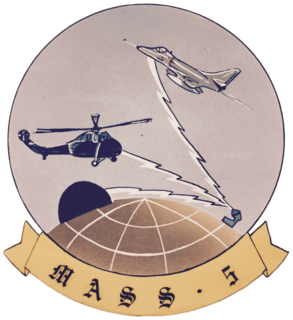
Marine Air Support Squadron 5 (MASS-5) was a United States Marine Corps aviation command and control unit that provided the Direct Air Support Center (DASC) capability for the I Marine Expeditionary Force from 1966 through 1969. MASS-5 was headquartered at Marine Corps Air Station El Toro, California, and was part of Marine Air Control Group 38 and the 3rd Marine Aircraft Wing.

Marine Air Support Squadron 4 (MASS-4) was a reserve United States Marine Corps aviation command and control unit that provided the Direct Air Support Center (DASC) capability from 1962 through the early 1990s. MASS-4 was headquartered at Naval Air Station Los Alamitos, California, and was part of Marine Air Control Group 48 (MACG-48) and the 4th Marine Aircraft Wing.
This page is based on this
Wikipedia article Text is available under the
CC BY-SA 4.0 license; additional terms may apply.
Images, videos and audio are available under their respective licenses.



















